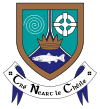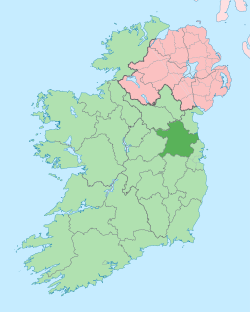Nadene Goldfoot
 |
| Ireland, by Lonely Planet |
I didn't realize that our ggrandfather, Abiathar Smith Robinson of Vermont's wife, Julia Ann Tuller, was of Irish descent. Her mother was Asenath Durkee b: 1814 in Royalton, Windsor, Vermont. Going back as far as the 1500's through other's endeavors, I find the line is traced back to 1507 in Dunmowe, Meath, Ireland and in 1580 to Drogheda, Louth, Ireland. Then in 1605 it is found in Platin Hall, Meath Ireland.
County Meath (/ m iː ð /; Irish: Contae na Mí or simply an Mhí) is a county in Ireland.It is in the province of Leinster and is part of the Mid-East Region.It is named after the historic Kingdom of Meath (from Midhe meaning "middle" or "centre").
County Meath
Contae na Mí
|
|---|
 Coat of arms
|
| Nickname(s):
The Royal County
|
Motto(s):
Tré Neart le Chéile (Irish)"Stronger Together"
|
|
 |
from Wikipedia
Pink area is northern Ireland with
Belfast as the largest city
Meath County is emerald green |
Here are our 5 generations from Ireland:
Descendants of Thomas D'Arcy
1 Thomas D'Arcy b: 1507 in Dunmowe, Meath, Ireland
. +Margaret Kiltole b: 1535 in Dunmow, Meath, Ireland m: Abt. 1558 in Donmow, Meath, Ireland
.... 2 John D'Arcy b: 1554 in Dunmow, Meath, Ireland
........ +Lady Margarete Drogheda b: in Drogheda, Louth, Ireland
.......... 3 William D'Arcy b: 1580 in Dunmow, Meath, Ireland
.............. +Lady Sarah Batham b: 1589 in Louth, Ireland d: 1680 in Rotherford, Sussex, England
................ 4 Sir William O'Durgy b: 1605 in Platin Hall, County Meath, Ireland d: 1648 in Battle of Drogheda
.................... +Lady Sarah Elizsabeth Batham b: 1610 in Rotherford, Sussex, England d: 1649 in Platin Hall, County Meath, Ireland
...................... 5 William Durgy Durkee b: Bet. 1632 - 1634 in Meath County, Ireland d: January 29, 1703/04 in Ipswich, Essex County, Massachusetts Bay Colony
.......................... +Martha Cross b: March 15, 1642/43 in Ipswich, Essex County, Massachusetts Bay Colony d: January 11, 1726/27 in Windham, Windham, Connecticut Colony. m: December 20, 1664 in Ipswich, Essex County, Massachusetts.
Now I find that Abiathar also has some interesting Irish elements in his DNA which is connected to the Ossory Fitzpatrick clan of Ireland.
Fitzpatrick is a very common name in Ireland. " It is the only native Gaelic name with the prefix Fitz..." "Most of the old Irish surnames that can be found throughout the world today have their roots in the Gaelic language. The original Gaelic form of the name Fitzpatrick is Mac Giolla Phadraig, an Irish chieftain, denoting a devotee of St. Patrick. This is the only native-Irish surname with the prefix "Fitz", as all others descend from the Normans."
 |
Abiathar with son Frank Hugh Robinson
part of the New England Robinsons of Vermont
who removed to Wenona, Marshall, Illinois where this was taken.
Frank's feet are on a haystack, so they could be posing in
the barn and they are all gussied up in their best clothes
for this event of picture-taking. Frank is adorable.
|
Our oral history from our grandfather, Frank Hugh Robinson, was that our ancestor came over not on the Mayflower of 1620 but the ship after that. That could have been 10 years later on the fleet of ships with Isaac Robinson, son of Reverend John Robinson who sent the Pilgrims on the Mayflower, but then the few DNA tested do not have our Y haplotype. Grandpa said they came from Wales, but then he was about 16 when he left home very angry at his father.
 |
| Norman Conquest. William the Conqueror's victory at the battle of Hastings in October 1066 was followed by six years of campaigning, which irrevocably established the new king's grip on England. |
To refresh our memories, "The Anglo-Normans were the medieval ruling class in England, composed mainly of a combination of ethnic Anglo-Saxons, Normans and French, following the Norman conquest. A small number of Normans had earlier befriended future Anglo-Saxon King of England, Edward the Confessor, during his exile in his mother's homeland of Normandy (part of France). The invading Normans came from the duchy of Normandy in the kingdom of France. They formed a ruling class in Britain, distinct from (although inter-marrying with) the native populations. When Edward returned to England some of them went with him, and so there were Normans already settled in England prior to the conquest. Following the death of Edward, the powerful Anglo-Saxon noble, Harold Godwinson, acceded to the English throne until his defeat by William, Duke of Normandy at the Battle of Hastings.
 |
| Castle of Teige Fitzpatrik, 4th Baron of Upper Ossary |
Irish Gaelic (Gaeilge nah Eireann) is a Celtic language spoken by 138,000 people as a first language, and by another 1,000,000 people as a second language in Ireland with 276,000 first-language speakers worldwide (Ethnologue).The language is sometimes referred to as Gaelic, Irish Gaelic, or Erse, but in Ireland it is simply called Irish.
 |
also from Wikipedia
County Kilkenny is a county in Ireland in emerald green. It is in the province of Leinster and is part of the South-East Region. It is named after the city of Kilkenny. Kilkenny County Council is the local authority for the county. |
In 1442, the Irish Treasury and Exchequer were petitioned to award 100 shillings to the Norman-affiliated inhabitants of the town of Kilkenny, for their military service against the neighbouring Gaels and "especially in breaching the castle of McKilpatrick.
Several peerages with titles including "Upper Ossory" have been created, all held by members of the Fitzpatrick family:
Our Frank Hugh Robinson said that his ancestor came from Wales. At 16, could he have
remembered incorrectly? What was going on in Great Britain around 1630? Why is
Northern Ireland different from the lower part of Ireland?
However did this small group of Islands of a United Kingdom have such
power in the world?










